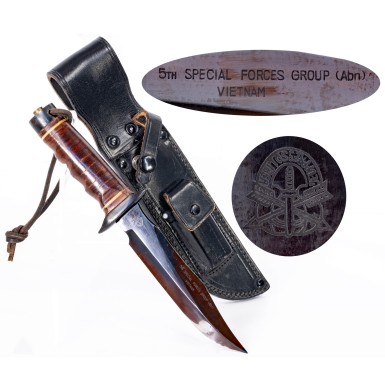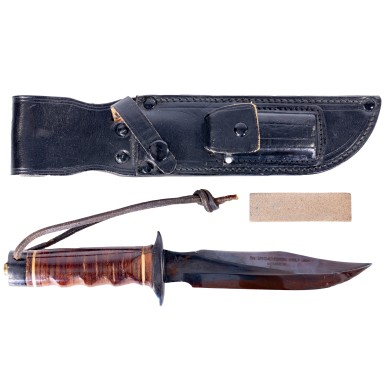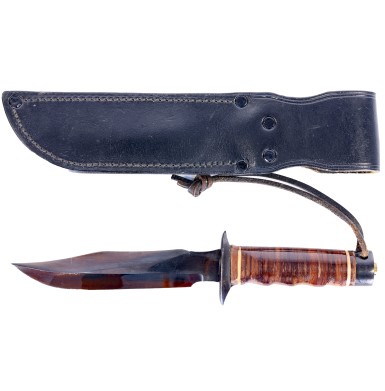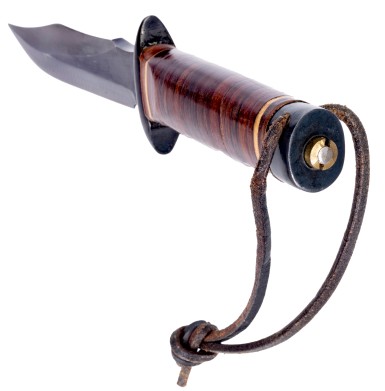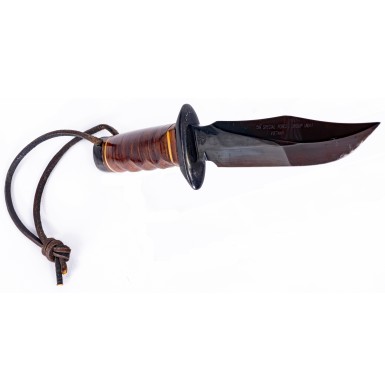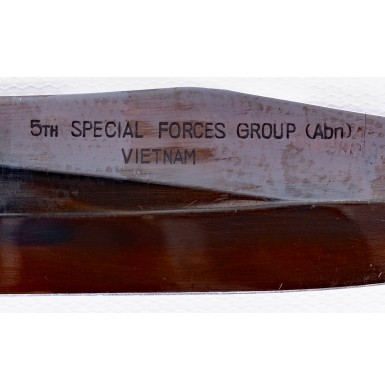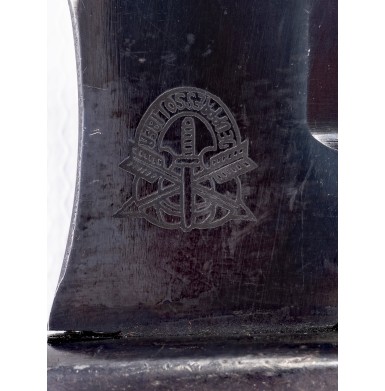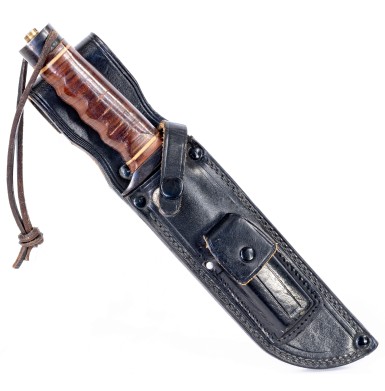Very Fine Published 5th Special Forces Presentation MACV-SOG Recon Knife
- Product Code: EWSK-GB214-SOLD
- Availability: Out Of Stock
-
$0.00
There are probably no more collectible and coveted edges weapons from the Vietnam War than those knives used by the men who made up the Military Assistance Command, Vietnam - Studies and Operations Group, known as MACV-SOG, during that conflict. From January 1964 to May of 1972 the various men and units assigned to work within the MACV-SOG structure were involved in unconventional warfare activities in the Republic of Vietnam (South Vietnam), the Democratic Republic of Vietnam (North Vietnam), Laos and Cambodia. The group was involved in nearly every major operation and even that took place during the war ranging from the Gulf of Tonkin incident, through Operation Steel Tire, Operation Tiger Hound, the Tet Offensive, Operation Commando Hunt, the Cambodian Campaign, Operation Lam Son 719 and the Easter Offensive. In May of 1972 operations were downsized and redesignated Strategic Technical Directorate Assistance Team 158. At this time the SOG units started their own Vietnamization of their activities, with the Army of the Republic of Vietnam taking over former SOG responsibilities. The duties of the member of MACV-SOG covered an array of activities, typically behind enemy lines. These duties included rescuing downed pilots, rescuing American prisoners, capturing enemy prisoners, conducting psychological warfare operations and numerous other clandestine activities. The majority of the men show served in within the MACV-SOG structure were US military special operators, including members of the Unites States Army Special Forces, the Navy SEALs and US Marine Corps’ Force Recon. These soldiers were often accompanied by CIA operatives during their missions. As these operations were invariably clandestine and typically behind enemy lines, an entire supply system to provide “sterile” clothing, arms and equipment was established. Of those specially procured, typically sterile items, none are more desirable to collectors today than the MACV-SOG “Recon” knives.
Research by noted fighting knife historian and author Michael W Silvey traces the evolution and procurement of the “Recon Knife”, sometimes referred to as the “CIA Knife” to Conrad B “Ben” Baker. According to Silvey’s historical summary of the SOG knives on page 264 of his book United States Military Knives 1941-1991, Baker served as the Chief of the Counterinsurgency Support Office, which was known as “CISO”. In that position he oversaw the procurement and supply of the friendly indigenous forces in the theaters of operations as well as the men of SOG. These supplies ranged from the most pedestrian things like personal hygiene items and the most basic of clothing items to camp and marching equipment and weapons. The edged weapons supplied by Baker included 7” and 6” “Recon Knives”, machetes and a small number of stilettos. Silvey’s research suggests that all of the edged weapons were produced in Southeast Asia.
The first of the SOG Recon Knives was a 7” bright bladed knife that was procured through the Okinawa based trading company Yoshi Shokai. Although that firm delivered the knives, it is not known who actually produced them. Minor variations between extant authentic examples may suggest more than one maker was involved. It appears that Baker was directly involved in the design of the original 7” knife. It had a single edged slightly curved, semi-clip point blade with a pronounced choil where the blade met the guard. The initial knives were made with brass fittings, a stacked leather washer grip and a lanyard hole in the pommel cap for a leather thong. Later knives would be produced with both iron and aluminum fittings. The knives were delivered with rivet reinforced black leather scabbards with hilt retention straps and a whetstone stored in a pouch on the face of the scabbard. The first group of 1,300 knives were ordered in June of 1864 at the price of $9.85 each. A second group of 1,200 knives with blued 6” blades were ordered in October of 1966 for $8.40 each. Neither of these groups of knives were numbered. A third group of knives was ordered in 1967 and were delivered between March and August. These knives were numbered. This third batch of knives were blued as well, but during the procurement process concerns about the heat bluing affecting the temper of the knives resulted a change to the bluing temperature and a change in the appearance of the blued finish. The knives in the latter portion of the 1967 deliveries tend to have an unevenly blued appearance with plum and reddish tones being seen, particularly along the edges of the blade where the steel is thinner. Silvey notes that the lower number knives, particularly below 600 tend to have more traditionally blued blades while the knives with higher numbers have the more plum toned blue. In addition to the standard, sterile issue knives, another 1,700 knives were procured in 1967 specifically for the 5thSpecial Forces Mess Association. These are the 5th Special Forces presentation knives that have a presentation legend on the obverse blade, as well as the Special Forces logo and motto on the obverse ricasso. While most were produced with a standard blade legend that read “5th Special Forces Group (Abn)” over “Vietnam” others had more personalized presentations that sometime include the name and rank of the recipient.
The history of the 5th Special Forces Group is best told in their own words from their own webpage on the US Military Special Operations Command website, https://www.soc.mil/USASFC/Groups/5th/5thSFGHistory.html and is related here:
“5th Special Forces Group (Airborne) derives its lineage from the 1st Special Service Force, a combined Canadian-American regiment during the Second World War. The force was constituted on July 5, 1942, in the Army of the United States as Headquarters and Headquarters Detachment, 1st Battalion, 3rd Regiment, 1st Special Service Force. \Activated on July 9, 1942, the unit trained at Fort William Henry Harrison, Montana. The force participated in the Italian Campaign, and saw action in Southern France before being inactivated on February 6, 1945.
The 5th SFG (A) was constituted on 15 April 1960 in the Regular Army and designated Headquarters and Headquarters Company, 5th SFG (A), 1st Special Forces.
On September 21, 1961, the 5th SFG (A) was officially activated at Fort Bragg, North Carolina. Just one year later, elements of the 5th SFG (A) began serving temporary tours of duty in the Republic of South Vietnam, with the full deployment of the group by February 1965. From its operational base at Nha Trang, the group deployed throughout the four military regions within South Vietnam. The group's operational detachments established and manned camps at 270 locations throughout South Vietnam, training and leading indigenous forces of the Civilian Irregular Defense Groups. Additionally, Soldiers from the group led units of indigenous forces conducting reconnaissance, and direct-action missions throughout Southeast Asia.
Although one of the smallest units engaged in Vietnam, the group colors fly 14 campaign streamers from that conflict, and its Soldiers are among the most decorated Soldiers in the history of our nation. Eighteen Medals of Honor were awarded to Soldiers of the 5th SFG (A) (nine posthumously). The group was awarded the Presidential Unit Citation, two Valorous Unit Citations, the Meritorious Unit Commendation, the Vietnamese Cross of Gallantry (with palm) and the Republic of Vietnam Civil Action Honor Medal, First Class.
On March 5, 1971, the colors of the 5th SFG (A) were returned to Fort Bragg, North Carolina, where the group remained until June 10, 1988 when the group colors were cased at a ceremony marking its departure from Fort Bragg. The colors were officially uncased on June 16, 1988.
The 5th SFG (A) added to its rich history of combat operations during Operations Desert Shield and Desert Storm. The group was called upon to conduct operations in Southwest Asia in response to the Iraqi invasion of Kuwait. The group deployed in August 1990, and returned in April 1991. During this time, the Group conducted Foreign Internal Defense operations in support of the Saudi Arabian land forces and provided Coalition Support Teams to every allied contingent among the coalition; becoming what Gen. H. Norman Schwarzkopf would call "the glue that held the coalition together." The group also conducted Special Reconnaissance, Direct Action, and Combat Search and Rescue Missions.
For their service during Operation Desert Storm the group was awarded the Valorous Unit Citation on June 11, 1993.
Following Operation Desert Storm, the group conducted extensive security and humanitarian missions in Somalia and was called to support operations in Haiti, Bosnia and Kosovo.
In the wake of September 11, 2001, the group was called upon to play a major role in the war on terror. The 5th SFG (A) was the first American unit deployed into Afghanistan for Operation Enduring Freedom. From October 2001 through April 2002, Special Forces detachments of the 5th SFG (A) conducted unconventional warfare against Taliban and Al Qaeda forces. Within six months, the 5th SFG (A), a regimental-sized force, effectively destroyed the popular base of the Taliban government and toppled the terrorist-sponsoring state of Afghanistan. The group was awarded the Presidential Unit Citation for its extraordinary accomplishments during Operation Enduring Freedom.
Immediately after redeploying to Fort Campbell, the group began preparations for Operation Iraqi Freedom. Within six months, elements of the Group deployed back into the theater of operations. In January 2003, the entire group completed deployment back to the U.S. Central Command area of responsibility. Upon the commencement of combat operations, the group conducted the full array of Special Forces missions from Theater Ballistic Defense in the Western Desert to unconventional warfare in Southern and Central Iraq. These efforts facilitated the defeat of Saddam Hussein's regime.
From the opening days of Operation Iraqi Freedom and the fall of the Baath Regime in 2003 through the final withdrawal of U.S. Forces and the end of Operation New Dawn in 2011, 5th SFG (A) has provided the full spectrum of Special Operations in support of Coalition Forces and the Iraqi government. The pinnacle of these achievements are evident in the thousands of successful operations targeting terrorist and insurgent networks through the training and development of the most capable and effective Iraqi Military, Police and Special Operations Forces. Special Forces Soldiers have proven again to be our nation’s ultimate combat multiplier, building skills and capabilities with multiple partner nation security forces across the CENTCOM area of operations, always prepared to execute the most hazardous and sensitive special operations when and where directed.
Recently, elements from 5th SFG (A) have returned to Afghanistan to train and advise Arab units participating in the international coalition. Additionally, detachments remain deployed throughout the CENTCOM area of operations, building, training and conducting sensitive Special Forces missions with partner nation and opposition forces throughout the Middle East.
As Soldiers of the group continue to serve on battlefields around the world, they uphold the highest of standards as paragons of the Special Forces motto: De Oppresso Liber, "to free the oppressed”.”
Offered here is one of those scarce and desirable 5th Special Forces Presentation SOG Recon Knives that only 1,700 of which were produced in 1967. It is a 6” blued blade knife that shows a substantial amount of plum and reddish tones on the blade, particularly along the edge and spine of the knife. The knife has blued steel fittings, including the oval guard and pommel cap. The obverse blade is marked with the standard two-line presentation legend that reads:
5TH SPECIAL FORCES GROUP (Abn)
VIETNAM
The Special Forces logo is crisply stamped on the obverse blade ricasso and includes the Special Forces motto De Oppresso Liber. This particular knife was published in Michael W Silvey’s book on SOG knives, SOG Knife Collectoron page 21. The blade has a wasp-waisted profile at the blade to hilt junction with a nominally 1” long dip at the spine and a .8” choil at the base of the blade. The clipped point Bowie style blade measures 6 3/16” from the guard to the tip and has a 2.75” false edge. The overall length of the knife is 10 ¾” with a 4.5” hilt. The thick blued steel guard in 3/16” thick at the widest point and is 2 ¼” in length. The blued steel pommel cap is ½” thick and is secured by a round brass spanner nut. A lanyard hole in the upper rear of the pommel cap has a leather thong passing through it, which terminates in a knot. The grip is stacked dark brown leather washers with two lighter colored whitish washers immediately before the first and last washer of the grip. The grip has four finger grooves to enhance the users grip on the knife. The knife is accompanied by its thick blade leather sewn scabbard with rivet reinforcements. The scabbard does not include a tie down thong hole and conforms to other known 5th Special Forces Presentation knife scabbards. It includes a pouch on the face which contains a dual grit gray and brown whetstone.
The knife remains in VERY FINE to NEAR EXCELLENT condition and retains nearly all of the original reddish toned blued finish on the blade. The finish shows some thinning and minor surface scuffing, with some very minor wear along the obverse edge at the tip where a few light scuffs suggest this small area, roughly 1 ½” in length, may have been lightly sharpened. Otherwise, the blade appears to retain its original edge. The steel fittings retain nearly all of their blued finish as well, with only some minor thinning, light wear and some minor surface scuffing. The stacked leather washer grip is in FINE condition as well and shows only some light handling marks and a few minor surface scuffs and scratches, likely from handling and possibly some carry. The scabbard remains in VERY FINE condition as well and shows only some light wear. This is evidenced by some minor finish loss to the blackened rivets and some very light and minor surface scuffing and light handling marks. The only portion of the scabbard that shows any real wear at all is some crazing and light wear to the hilt retention strap and whetstone flap. Both the hilt strap and whetstone flap snaps are in fine condition and work as they should.
Overall, this is a really wonderful example of a scarce and desirable Vietnam MACV-SOG 5th Special Forces Presentation Knife. According to Michael W Silvey’s research only 1,700 of these knives were ordered for the 5thSpecial Forces Mess Association in 1967 and these knives were distributed to those who served with the 5th Special Forces Group in Vietnam. These scarce knives are always desirable for US military edged weapons collectors, and this particular one is published in the leading text on the knives used by the Special Operations Group in Vietnam. I am sure you will be very happy to add this fine presentation knife to your collection and will enjoy displaying it with your advanced military edged weapons collection.
SOLD
Tags: Very, Fine, Published, 5th, Special, Forces, Presentation, MACV-SOG, Recon, Knife

